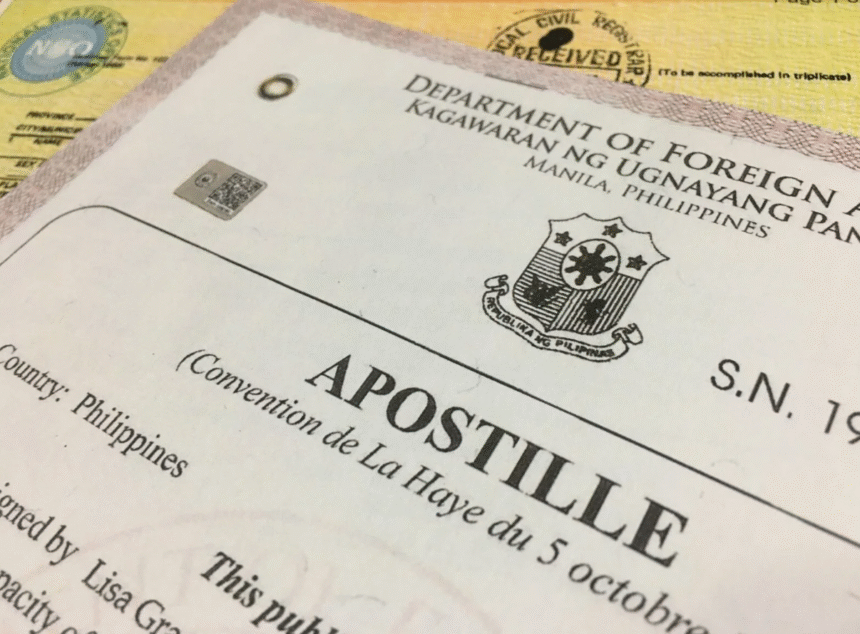Apostilles are often the last thing people think about until they’re urgently needed. Whether you’re moving abroad, applying for a visa, or presenting credentials overseas, a minor error in the apostille process can result in unexpected delays or even the outright rejection of your paperwork. With different rules for various countries and document types, the process can feel more complicated than it needs to be.
- What Is an Apostille and Why Is It Important?
- Definition of an Apostille
- Types of Documents That Typically Need Apostilles
- Why Getting It Right Matters
- Common Mistakes People Make When Getting Documents Apostilled
- 1. Submitting the Wrong Type of Document
- 2. Choosing the Wrong Apostille Authority
- 3. Overlooking Document Requirements and Timing
- 4. Missing Deadlines or Using Expired Documents
- 5. Forgetting About Translation Requirements
- 6. Using the Wrong Payment or Submission Method
- Step-by-Step Guide: How to Get an Apostille Without Mistakes
- Step 1 – Verify Your Document Type
- Step 2 – Identify the Correct Authority
- Step 3 – Review Destination Country Requirements
- Step 4 – Organize Your Timeline
- Step 5 – Consider Professional Apostille Services
- Final Tips for a Smooth Apostille Process
- The Correct Apostille Process — Efficient Process
To help you avoid costly setbacks, this guide covers the common apostille issues people face and exactly how to get it right. We’ll also walk you through a reliable step-by-step method for handling everything smoothly, from the very first form to final approval.
What Is an Apostille and Why Is It Important?
Getting an apostille isn’t just another stamp but a legal requirement for many official documents used outside your home country. No matter if you’re dealing with birth certificates, marriage records, diplomas, or power of attorney forms, a properly issued apostille proves that your document is authentic and officially recognized in another country.
Understanding what it is and why it matters will help you avoid unnecessary confusion and make sure your documents are accepted without extra hassle.
Definition of an Apostille
An apostille is a type of international certification issued under the Hague Apostille Convention of 1961. It authenticates the origin of a public document, verifying the seal, signature, and authority of the official who signed it, so that it can be legally used in another participating country.
This certification does not validate the content of the document. Instead, it confirms that the official or notary who issued or certified the document is recognized by the government.
Types of Documents That Typically Need Apostilles
Only certain types of documents qualify for apostille services, and this can depend on both the document type and the destination country. Here are the most common:
- Birth, marriage, and death certificates
- Academic diplomas and transcripts
- Court rulings or judgments
- Notarized powers of attorney
- Background checks
- Business documents like incorporation papers
The document must be issued or certified by a recognized public authority. Personal letters or private agreements often do not qualify unless notarized.
Why Getting It Right Matters
Mistakes in the document apostille process can cause more than just delays; they can stop your application, visa, or legal process altogether. Many institutions abroad will reject improperly certified documents without explanation, leaving you to start over.
When you’re applying for jobs, enrolling in school, or managing time-sensitive legal or immigration matters, resubmitting paperwork isn’t always an option. Getting the apostille right the first time saves time, money, and frustration.
Common Mistakes People Make When Getting Documents Apostilled
Most people don’t realize how technical the apostille requirements can be until something goes wrong. Small details like sending the wrong document version or mailing it to the wrong office can lead to complete rejection.
This section breaks down the most common problems that delay or derail the apostille process.
1. Submitting the Wrong Type of Document
Not all documents can be apostilled. One of the most frequent errors is trying to submit photocopies or unofficial versions instead of the certified originals.
For example:
- A scanned copy of a birth certificate is not acceptable, even if printed in color.
- Documents without the proper seals or signatures are automatically rejected.
- Some commercial documents require additional notarization before being eligible.
Always confirm whether your document needs to be the original, a certified copy, or a notarized version before submitting it for apostille services.
2. Choosing the Wrong Apostille Authority
Every jurisdiction has a designated apostille authority, and sending your documents to the wrong one will delay your application. This is a common issue when people confuse federal and state-level processes.
Here’s how it works:
- State-issued documents (like birth certificates or diplomas) must go through that state’s Secretary of State office.
- Federal documents (like FBI background checks) must be processed by the U.S. Department of State.
Misdirecting your request, even by a single level of government, is one of the most avoidable apostille mistakes.
3. Overlooking Document Requirements and Timing
Every document has a unique set of apostille requirements. These vary depending on the issuing authority, the type of document, and the destination country.
Here’s where people often go wrong:
- Submitting documents that haven’t been notarized (when required)
- Ignoring specific instructions from the Secretary of State’s office
- Using old or damaged documents that are no longer valid
It’s also critical to understand how long the process takes. Some states process apostilles in a few days, while others may take weeks. Failing to account for this can cause delays, especially when dealing with consular deadlines or school application windows.
4. Missing Deadlines or Using Expired Documents
One of the most overlooked problems is document expiration. Even if your paper appears official, some receiving authorities require that it be issued within a specific time frame, commonly within the last 3 to 6 months.
Missing deadlines can result from:
- Not starting early enough
- Relying on regular mail instead of tracked or expedited options
- Assuming processing times are the same in every state
This is particularly important when working on legal, academic, or immigration-related submissions. Always verify both the timeline for how to get an apostille and the accepted age of the document in the destination country.
5. Forgetting About Translation Requirements
Many applicants don’t realize that submitting documents in a foreign country may require an official translation. Even if the document is correctly apostilled, it can still be rejected if the receiving authority cannot read or verify it in their native language.
Common translation-related apostille mistakes include:
- Submitting a self-translated document instead of using a certified translator
- Failing to include the translation of the apostille certificate itself
- Assuming all countries will accept English-language documents
Some jurisdictions require the translation to be notarized before the apostille is applied, while others need it after. Make sure to confirm whether a translation is needed and when it should be completed in your apostille step-by-step process.
6. Using the Wrong Payment or Submission Method
Even a perfectly prepared document can be rejected if the payment method isn’t accepted or if the submission instructions aren’t followed exactly.
Here’s what often goes wrong:
- Sending cash instead of a check or money order
- Using outdated forms
- Forgetting to include a self-addressed, prepaid return envelope
- Submitting the request to the wrong address
Different states and authorities have different rules. Some accept walk-in requests, others only process mailed submissions. Many require specific types of payment. Failing to follow these exact guidelines can result in a complete return of your paperwork without explanation.
These minor errors add up, especially when you’re working under tight deadlines. Always double-check submission rules and payment details before mailing anything out.
Step-by-Step Guide: How to Get an Apostille Without Mistakes
This section offers a clear and actionable apostille guide to help you avoid common errors and ensure your documents are prepared correctly from the start.
Step 1 – Verify Your Document Type
Start by identifying whether your document qualifies for an apostille.
Eligible document types often include:
- Birth, marriage, and death certificates
- Academic records and diplomas
- Power of attorney documents
- Business or commercial agreements
Your document must either be the original or a notarized copy, depending on the type. Submitting a photocopy or an unnotarized version is one of the most frequent apostille mistakes.
Also, make sure your document hasn’t expired or been altered. Some countries may reject documents that are older than six months or contain corrections or damage.
Step 2 – Identify the Correct Authority
In the U.S., apostille services are not handled at the federal level unless the document is federal in nature (like an FBI background check).
For most documents:
- State-issued documents must be apostilled by that state’s Secretary of State office
- Federal documents go through the U.S. Department of State
- Academic or personal documents might require preliminary authentication before an apostille
Selecting the wrong office or authority is a common issue. Take time to verify which apostille authority handles your specific document type and location.
Step 3 – Review Destination Country Requirements
Even if your document is correctly apostilled, it may still be rejected abroad if you haven’t followed the destination country’s specific rules.
Different countries have different apostille requirements, such as:
- Whether the apostille must be recent (issued within 3–6 months)
- If documents need to be translated before or after the apostille is issued
- Whether notarization is required before submission
- Acceptance of electronic apostilles (not all countries recognize them)
Before submitting anything, research the exact requirements of the country where you’ll be using the document. Misunderstanding this step leads to many common apostille issues, especially for time-sensitive processes like immigration or international marriage.
Step 4 – Organize Your Timeline
Processing times can vary drastically based on the document type, issuing authority, and method of submission. Waiting too long to begin the process is a mistake that can derail travel, legal deadlines, or overseas job opportunities.
To avoid unnecessary stress:
- Account for mailing time to and from the issuing office
- Add extra time if documents must go through multiple levels of certification before an apostille
- Be aware of holiday schedules and peak processing seasons
If time is short, consider using a professional service like EZ Apostille, which can guide you through the process more efficiently and help reduce costly delays.
Step 5 – Consider Professional Apostille Services
Handling the apostille process on your own is possible, but it’s easy to make avoidable mistakes, especially when you’re dealing with multiple documents, tight deadlines, or unfamiliar country-specific rules.
This is where professional apostille services become useful. An experienced provider can:
- Identify the correct apostille authority
- Review your documents for accuracy before submission
- Handle mailing, payments, and tracking on your behalf
- Speed up the process by avoiding rejections due to common mistakes
If you’re unsure how to get an apostille without errors, using a professional service can save you both time and stress. Providers familiar with apostille procedures know how to navigate requirements across all 50 states and can help ensure your documents are accepted the first time.
While there’s an added cost, the peace of mind and faster turnaround time are often worth the investment, especially for immigration, legal, or academic purposes where deadlines are non-negotiable.
Final Tips for a Smooth Apostille Process
Once you understand the full apostille guide, you can take a few extra steps to make sure everything runs smoothly from start to finish.
Here are a few final apostille tips to help you avoid last-minute surprises:
- Double-check your documents. Make sure you’re sending the correct type, certified, clean, and properly issued. Documents with missing seals, faded text, or visible damage may be rejected without review.
- Use tracking for all submissions. Whether you’re mailing documents to a state agency or working with a service, always use a tracked delivery option both ways. This is the simplest way to prevent lost paperwork and unnecessary delays.
- Start early. Even if you plan to use an expedited apostille service, allow room for unexpected delays. Having extra time means you can fix mistakes without missing deadlines or resubmitting in a rush.
- Keep copies of everything. From your application forms to a scan of the original document, having digital or paper backups can be a lifesaver if something gets misplaced or rejected.
- Avoid overcomplicating the process. Do not notarize documents that don’t require it. Avoid unnecessary staples, clips, or added sheets unless instructed. The simpler and cleaner your documents, the fewer problems you’ll face.
Following these tips will significantly reduce your chances of running into common apostille issues — and help ensure your paperwork is accepted overseas without delays.
The Correct Apostille Process — Efficient Process
Getting documents authenticated for international use is a process that must be completed correctly to be effective. Small missteps in timing, paperwork, or authority choice can lead to delays or outright rejection. That’s why you must understand that the full apostille process, from eligibility to final submission, is essential.















